Wat a surprise! I am blessed because a friend randomly showed up with a delightful gift. He told me he went into a local liquor store and asked for a “top shelf Czech liquor product,” and the man at the liquor store sold him a beautiful bottle of R. Jelinek’s Pear Williams Pear Brandy (or hruškovice as it’s called in Czech).
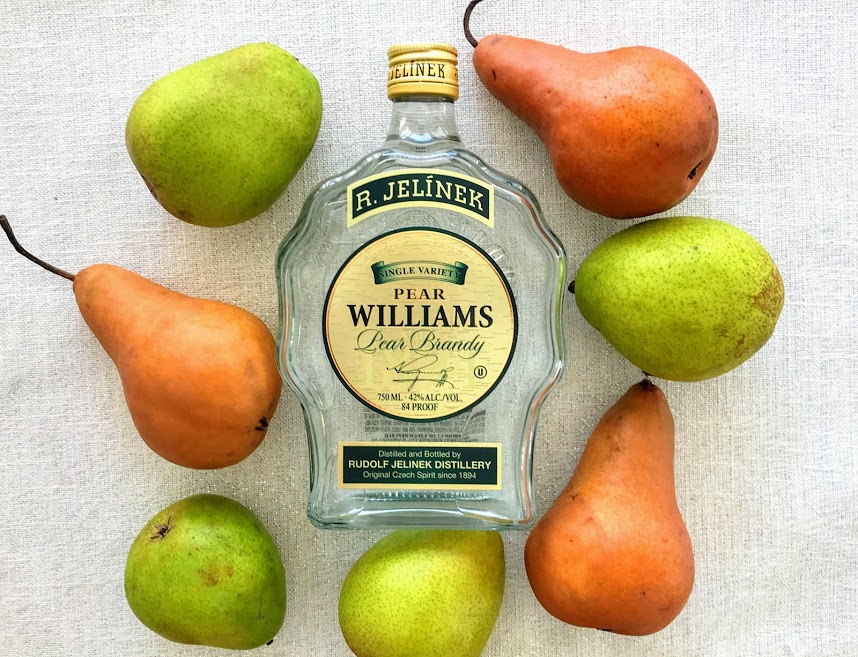
I’m happy to discover that this isn’t a Czech label that is made elsewhere – this is actually distilled and bottled by Rudolf Jelinek Distilleries and is an actual product of the Czech Republic. A taste of HOME coming just at the right time.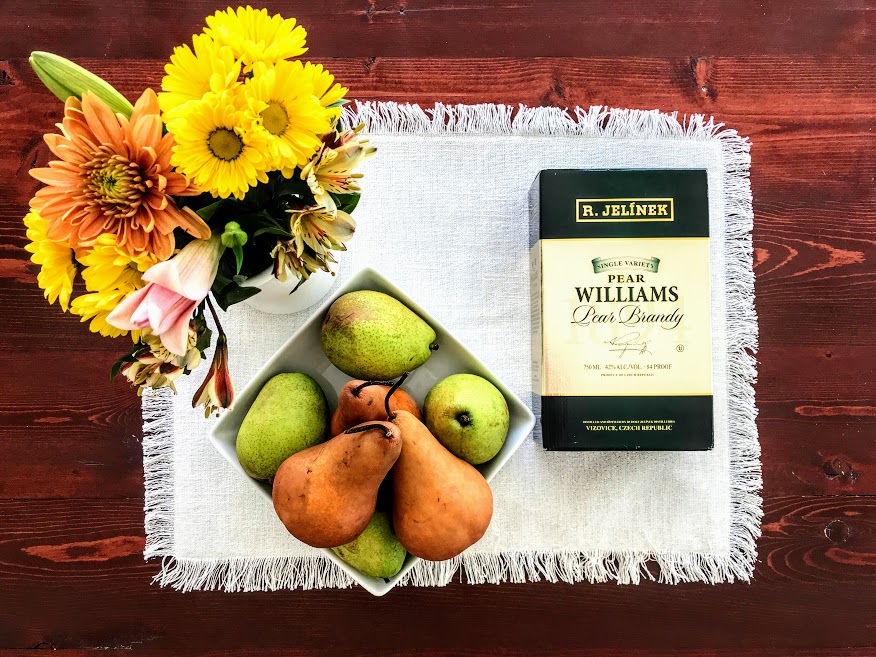
Pear Williams Pear Brandy is made in Vizovice, which is a town in the Zlín Region, in the Vizovice Highlands. It has a population of around 4,800 inhabitants. This part of Bohemia is where Slivovice was born. According to old manuscripts and ledgers from the 17th Century, there were approximately seventy thousand (70,000) plum trees known to be in existence at the time in the area surrounding Vizovice. In fact, so abundant was the fruit that the area was known as The Valley of Plums.
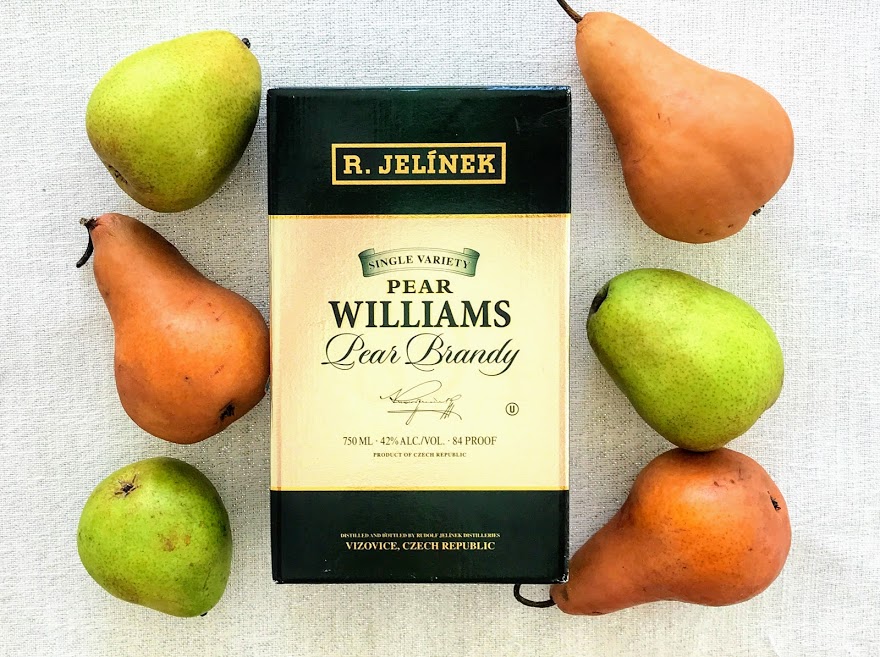
Pear brandy is not as widespread in the Czech Republic as it is in the West, but Rudolf Jelinek distillery is changing that. Known for their slivovice which has been produced for over 120 years, they have recently created this Kosher version of a top-shelf product.
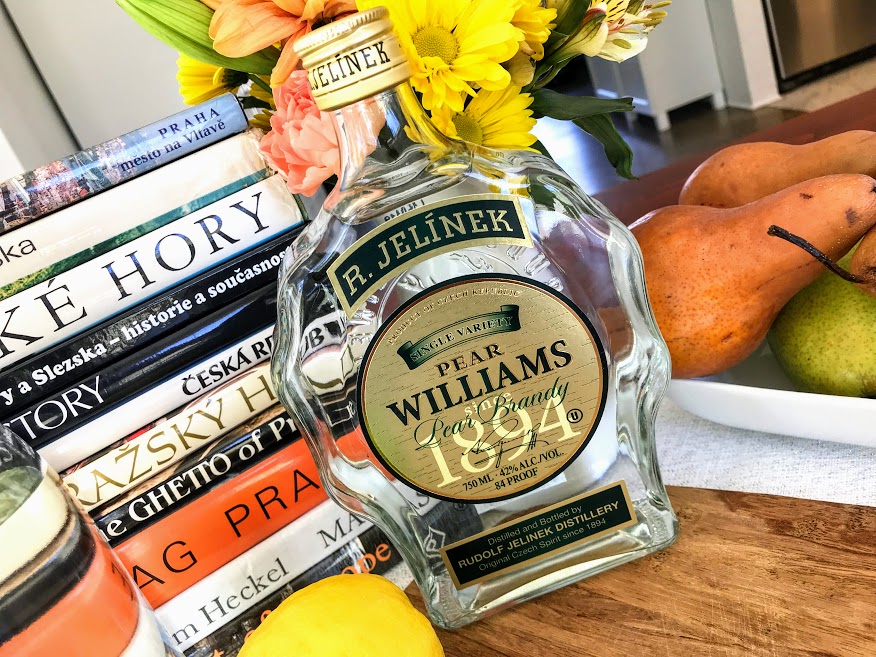
The very first market in the United States for R. Jelinek Slivovitz was in New York. An old American Wine and Liquor Journal ad dated January 1935 shows the product.
Packed in a lovely 750 ml. bottle with 42% alcohol, this pear brandy is 84 proof.
After an afternoon of tasting it both plain and in several cocktails, I must admit – it’s my new favorite indulgence. The best part is that you can sip a good pear brandy straight from the glass because brandy has long been a clever way of preserving excess fruit that would otherwise rot. Because the pears are picked at the peak of ripeness, the finished spirit has an incredible aromatic pear essence. After doing some in-depth research, I found that it takes roughly 30 pounds of fresh fruit to make each bottle!
Depending on the time of year, the special variety of Pear Williams pears is sourced from three different continents. (You’ll learn why a bit later in this post.) Then, using the same methods of production handed down for over five generations, R. Jelinek master distillers create a fragrant and delicious product that truly has an exquisite aroma and taste, and it’s even Kosher!
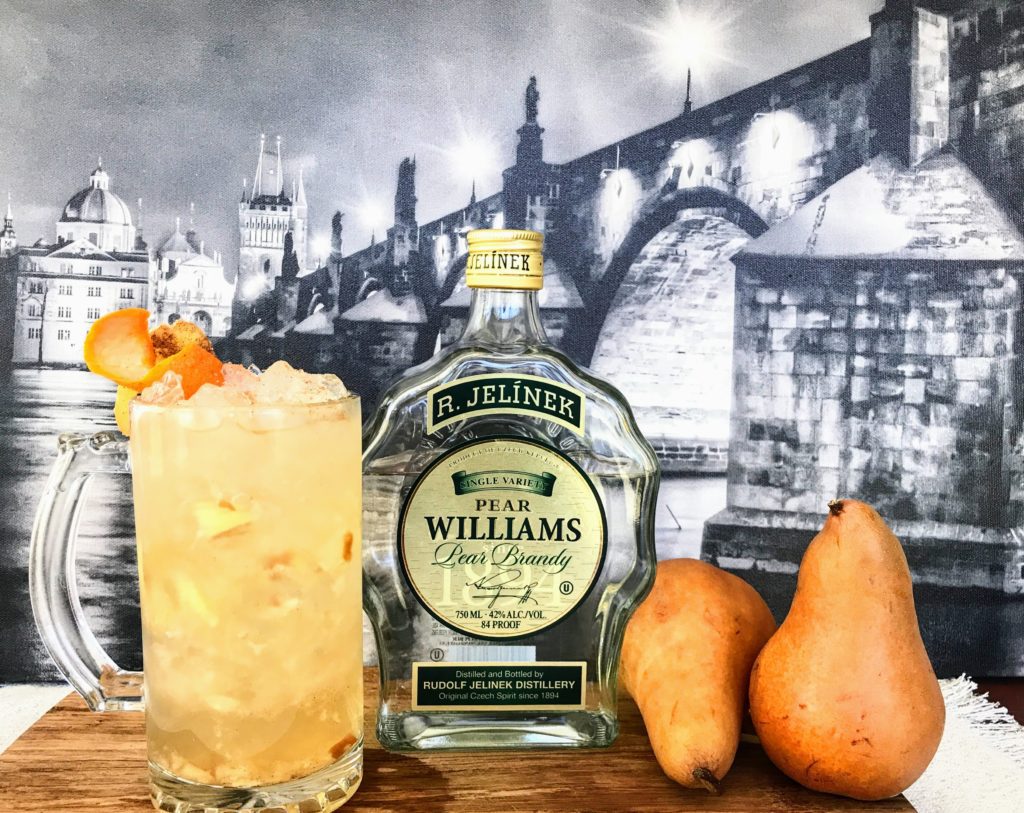
Believe it or not, it was the Jews from Eastern Europe who adopted Slivovice and Hruškovice as their national alcoholic beverage. This factor, supported by huge Eastern European immigration in the 20th century, was crucial to spreading the voice of fruit spirits around the world. Plum and pear brandy would likely be confined to its local boundaries without them. But mass emigration after the World Wars took them to America, Australia, and Israel. The young generations were drinking both Slivovice and Hruškovice, and they were spreading the word about it. With their specific aroma, taste, and clarity, Pear brandy and plum brandy easily made their way to non-Jewish consumers.
So how does it taste?
Drinkers often remark on the fragrant, fruit-forward aroma of hruškovice and then find themselves surprised by the potent nature of the flavor. Hruškovice has very distinct qualities that you cannot find in other brandies – or any other spirit, for that matter.
How do you drink Hruškovice?
Pear Williams Pear Brandy has a pleasantly delicate, fruity flavor with a distinctive aftertaste, and I believe that after tasting it, you, too, will become enthusiastic about its delicate fruity flavor. You can literally smell the pears when you pop open the bottle.
I asked my son Zachary, bartender extraordinaire, what he would suggest for this Pear Williams Pear Brandy, and he came up with the following five cocktail recipes, which I was happy to sample for the writing of this post.
Bohemian Pear Orchard
Ingredients
- 1 1/2 ounces Pear Williams Pear Brandy
- 1 ounce pear nectar
- Champagne for topping
- Pears, sliced into thin pieces for garnish
Shake all ingredients with ice, then pour over ice into a glass. Garnish with a cinnamon-dipped pear slice.
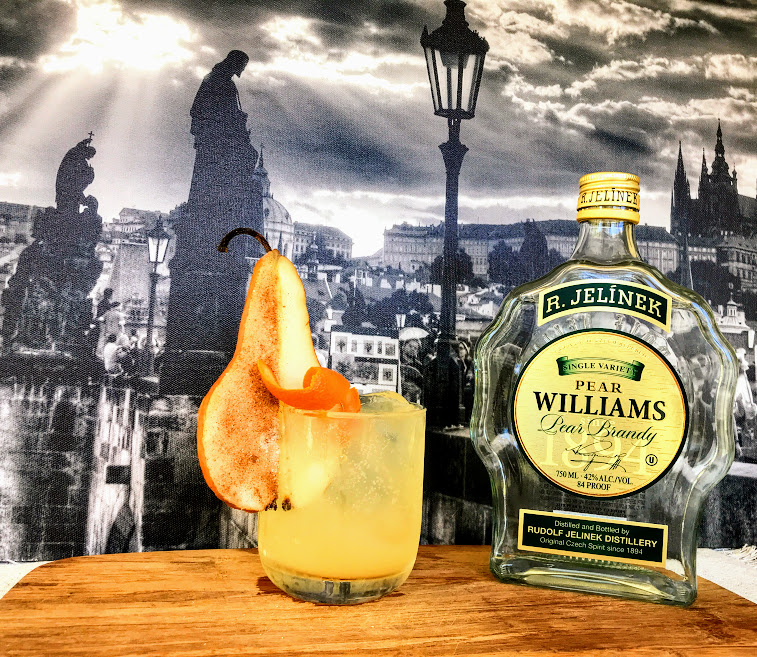
Bohemian Pear Brandy Martini
Ingredients
- 1 oz Pear Williams Pear Brandy
- 1 oz vodka
- 1/2 oz simple syrup (see note at bottom)
- 1/2 oz fresh lime juice
Shake all ingredients with ice, then strain into a chilled cocktail glass. Garnish with a lime twist.
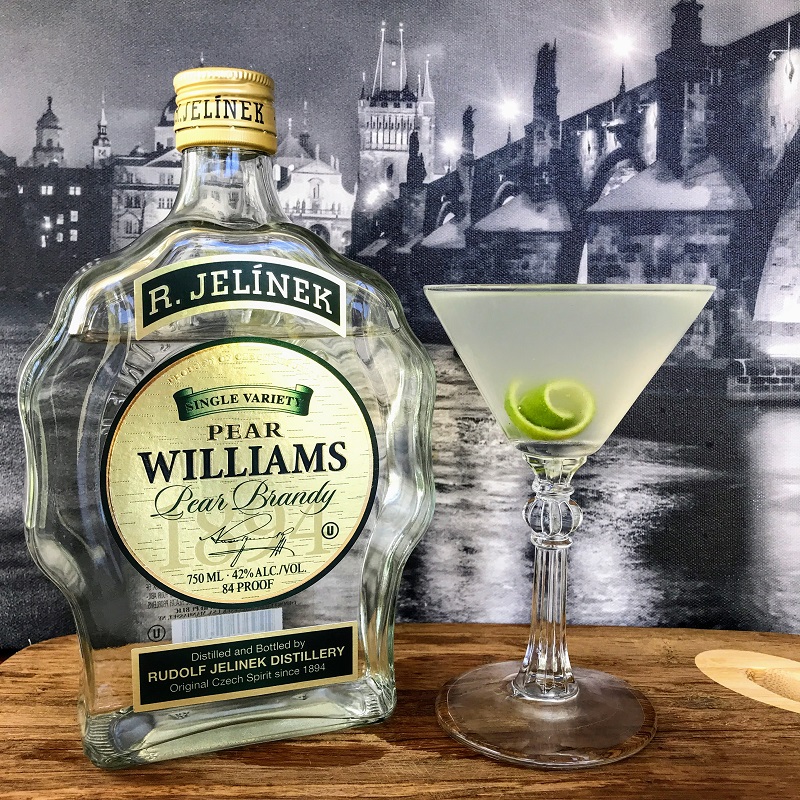
Bohemian Pear Brandy Cooler
Ingredients
1 1/2 oz Pear Williams Pear Brandy
1/2 oz Orgeat (see note at bottom)
soda water
Pour pear brandy and orgeat into a highball glass filled with ice and stir. Top with soda water.
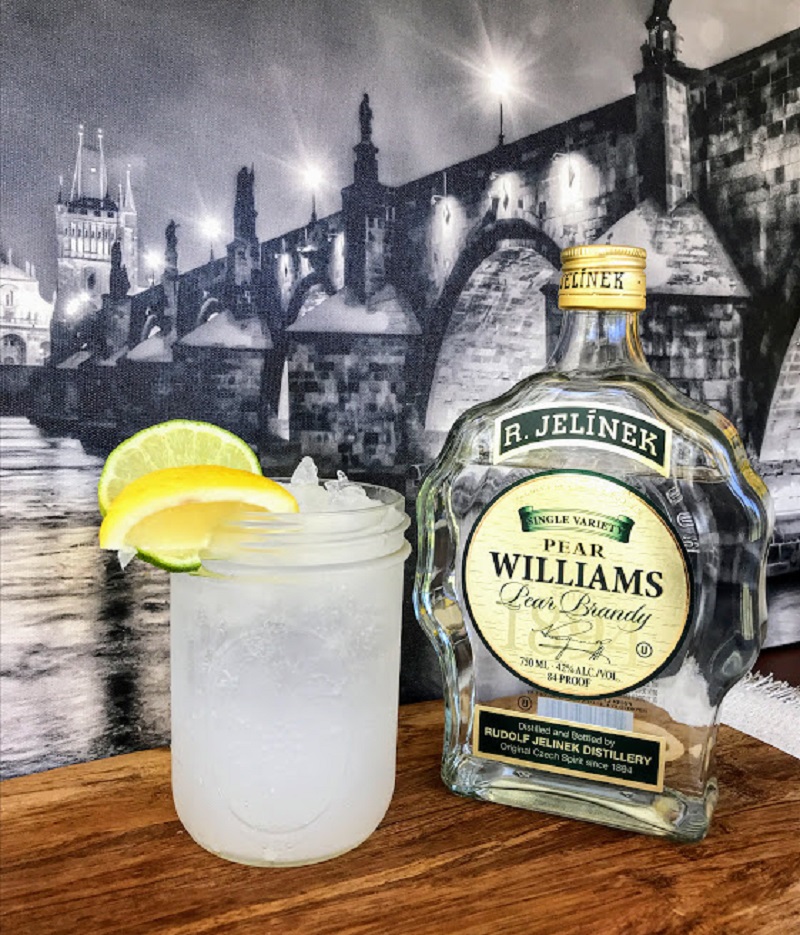
The Countess’ Carriage (a play on a classic sidecar)
Ingredients
1 1/2 oz Pear Williams Pear Brandy
1/2 oz ginger liqueur or ginger ale
1/2 oz fresh lemon juice
1/2 oz simple syrup (see note at bottom)
Pour the brandy, lemon juice, simple syrup, and ginger ale into a cocktail shaker over ice. Cover, and shake until the outside of the shaker has frosted. Strain into a sugar-rimmed cocktail glass to serve.
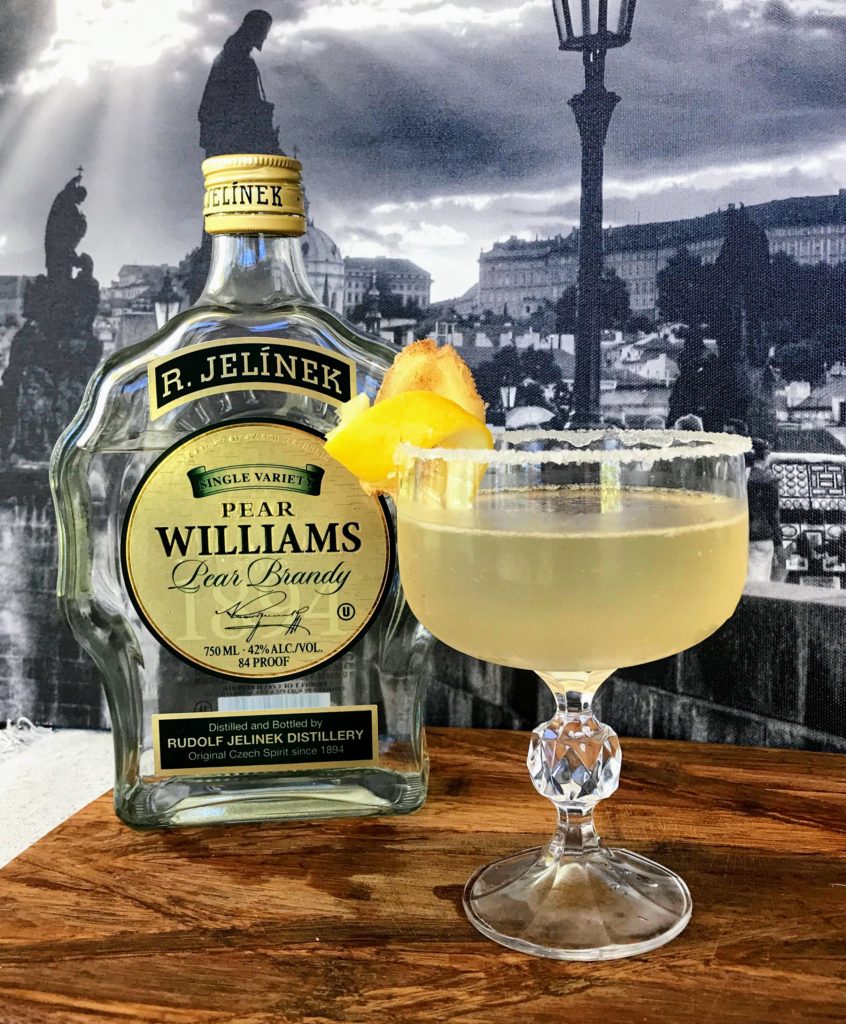
And my absolute favorite… (Zachary is a genius!)
Bohemian Autumn
Ingredients
- 1 to 2 oz Pear Williams Pear Brandy
- 1/2 oz maple syrup
- 2 sugar cubes
- dash of cinnamon
- ginger ale
Place sugar cubes in glass, muddle pear and fresh ginger, add liquor and cinnamon and place in tall glass over ice.
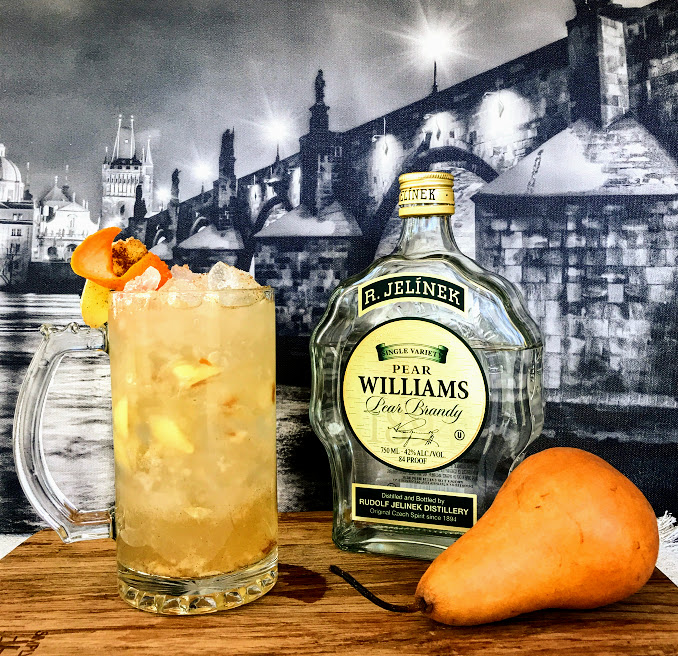
My son’s creation for Bohemian Autumn reminded me of Prague in the fall with its harvest flavor and aroma. If you are not accustomed to the taste of pear brandy (Hruškovice), then this is a way to acquaint yourself with the liquor and get a taste for it.
And, of course, you can also drink it straight, preferably chilled. With all the news about the Coronavirus, I’m sure Czechs will agree this should be called the Corona Killer.
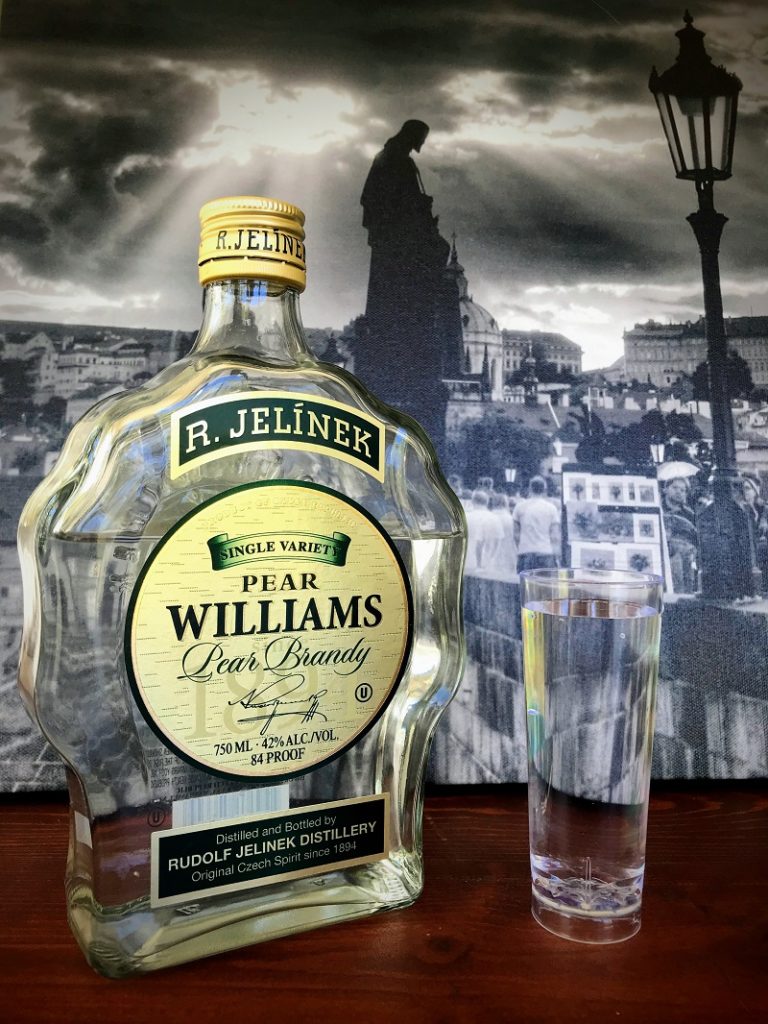
The best part of this tasty Czech Pear Williams Pear Brandy is, as I mentioned above that you can have an authentic Czech drink to add to your bar repertoire. When your friends come, and you want to impress them with a cocktail from the homeland, make sure to pull this out and share some interesting Czech trivia with them.
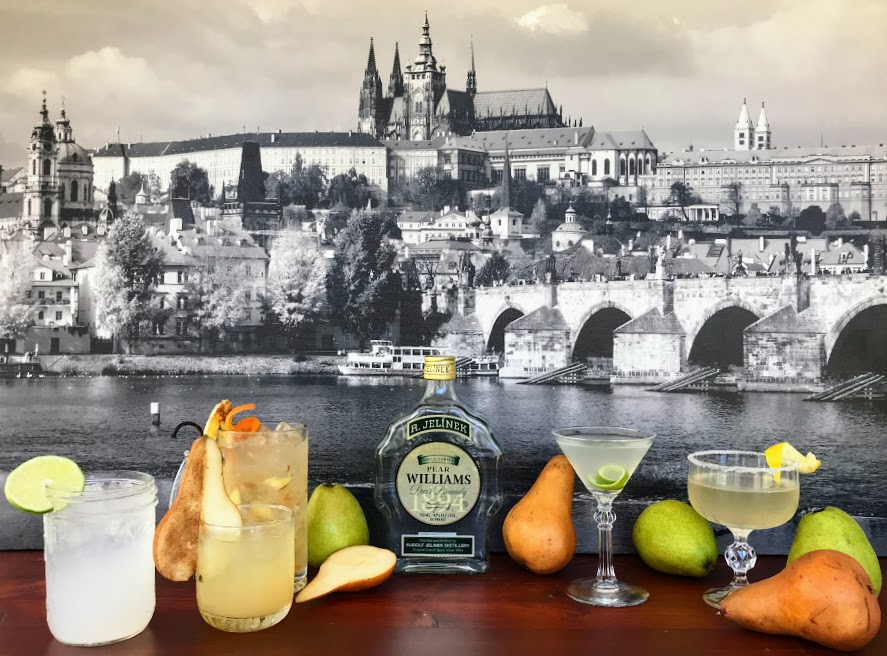
The journey of pear trees to Europe probably led through Greece, as evidenced by ancient literature. For example, the pupil of Aristotle Theofrast mentions the cultivation of four kinds of pears called “apeos” in his Historia Plantarum. His writings also tell us that pears were not consumed raw but either cooked or dried. From Greece, there was only a short journey of pears to Rome. Marcus Plinius Cato in Historia Naturalis states that 35 pears were grown in Roman gardens in the years 23-79 AD.
Even in the fairy tales of the Thousand and One Nights, it is mentioned that pears and pears were served as a delicacy at the royal banquets.
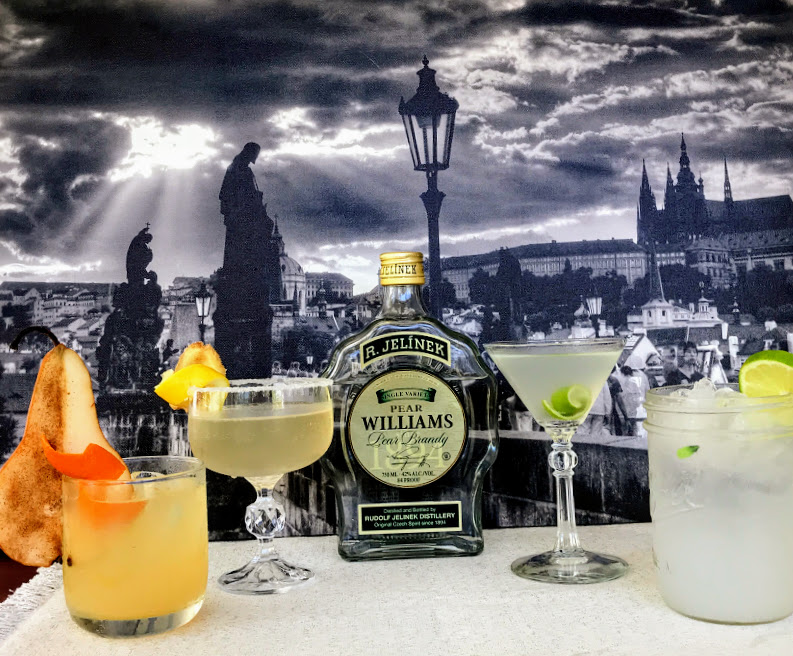
The cultivation of pear trees in Central Europe probably penetrated already between the first and fifth centuries AD, most likely with the arrival of the Slavs or thanks to the Roman legions. Pears then reached their peak during the Middle Ages during the reign of Louis XIII. and XIV, when there were over 900 varieties!
In Bohemia and Moravia, pears were first cultivated in aristocratic and monastic orchards and gardens, but soon they found their way to rural gardens as well. In the Czech lands, 112 different varieties were documented, some of these included the following: Bartholomew, Barvička, Cibulka, Cvergli, Jakubička, Krvavka, Majdalenka, Pstružka, Ovesňačka, Starna panna, Spinka, Vavrinka or Žitnicka.
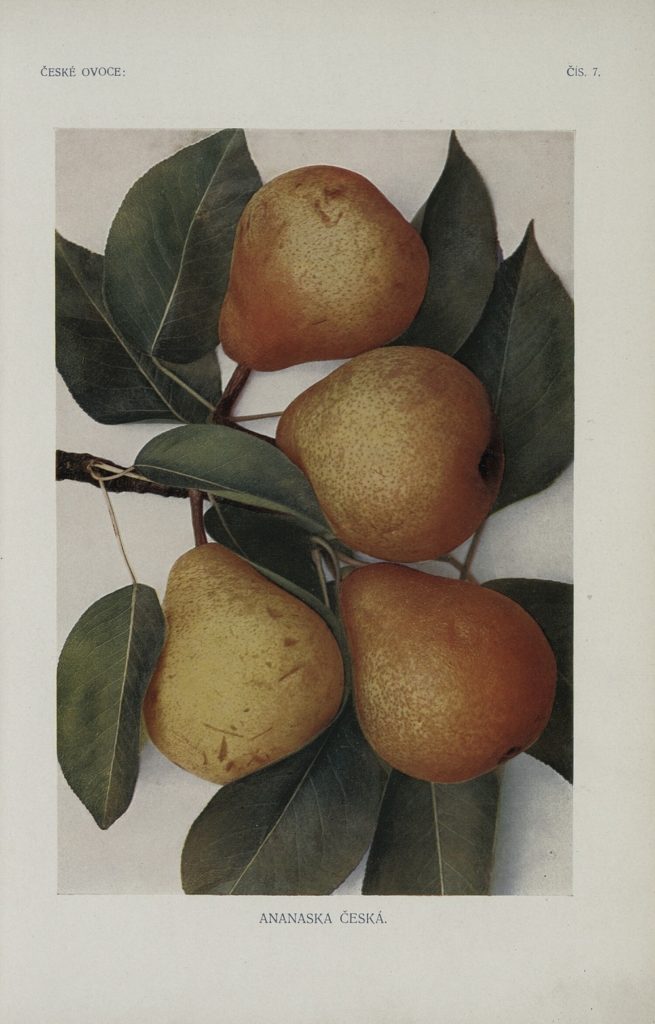
So what happened to all of the pear orchards?
Large pear trees are difficult to fit into small gardens; over time, many owners preferred ornamental rather than utility gardens. There was also a wave of disease known as ‘pear rust’ that wiped out many varieties and contributed to overall pear reduction. Another wave of abandonment of pear trees began by making way for sugar beet growing in the second half of the 19th Century.
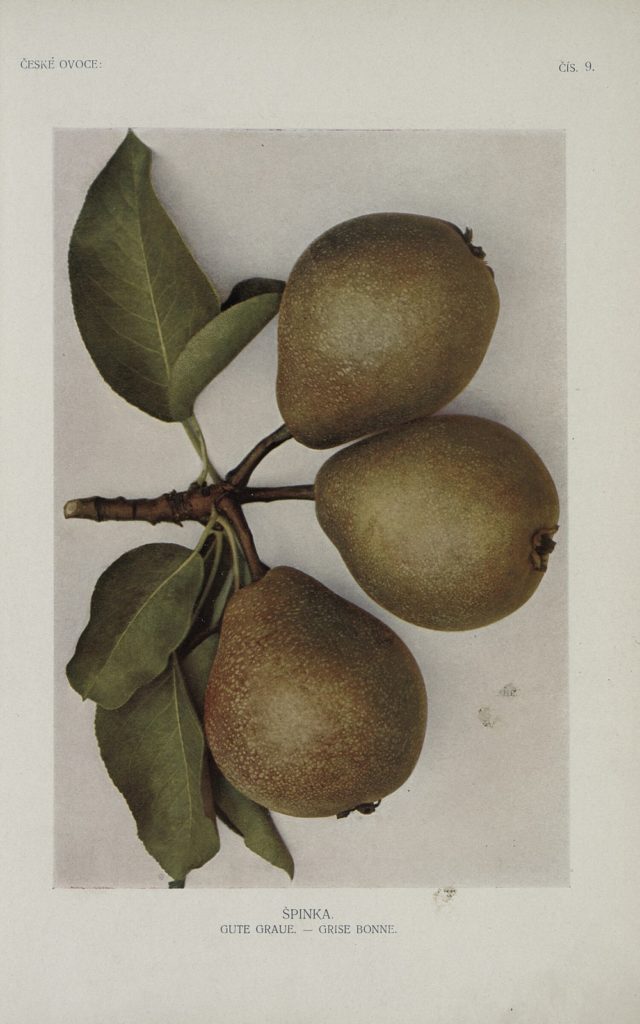
They mostly remained successful in the Elbe region and on the warming hills of the Litoměřice and Lovosice districts. The final end of the glory of the Czech pear brought a dark period of collectivization.
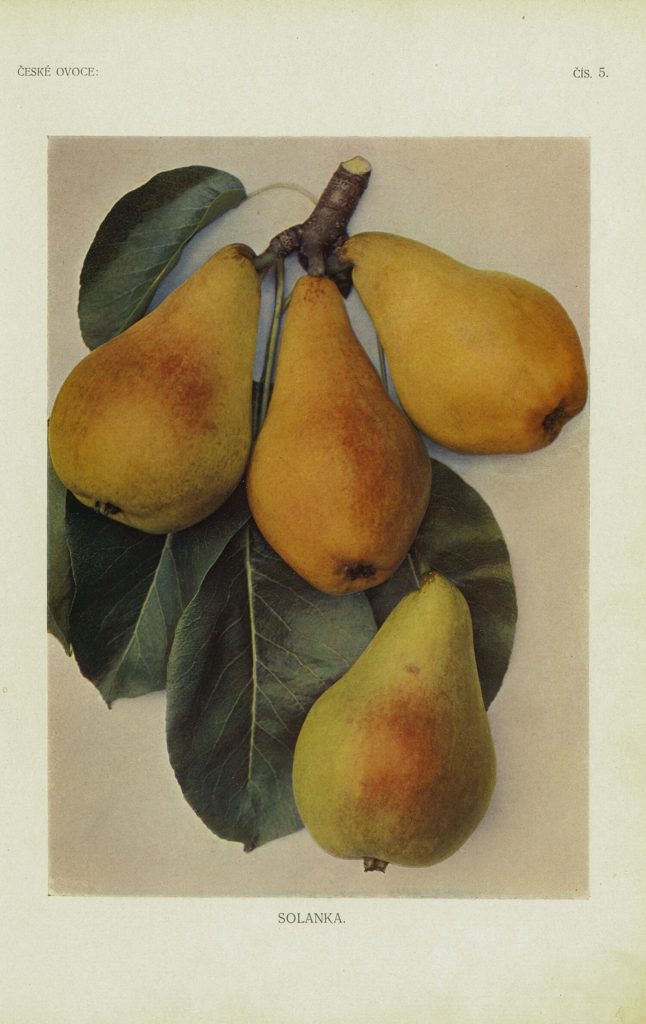
Though the old pear trees persisted for a long time, they were eventually overgrown by impenetrable thorny shrubs and uncombed by anyone; they would be burnt along the roads.
Czech varieties that do remain in very limited amounts are the Solanka, Zbuzanka, Muškatelka, Koporečka, Magdalenka, and Ananaska česká. Looking at season growth which is making a comeback, I found the following active in the Czech Republic: Summer cultivars ‘Isolda’ and ‘Radana’; autumn cultivars ‘Elektra’ and ‘Manon’; early winter cultivars ‘Vonka,’ ‘David’ and ‘Dicolor’; winter cultivars ‘Bohemica,’ ‘Astra,’ ‘Dita,’ ‘Erika’ and ‘Omega.’
Variations of both slivovice and hruškovice can be found widely in most Czech homes, and many people take great pride in producing it privately from their own fruit trees. Which is legal there, by the way. But for those who do not have access to fruit trees, R. Jelinek is the go-to brand.
Czechs don’t just drink this recreationally. They use this as medicine for whatever ails you. It’s been said it can ease a toothache, calm an upset stomach, rid you of a cold or the flu, and even aid with digestion. At 47 proof, it can also be used as an anesthetic! As a guest in a Czech home, you’ll usually be poured a shot without even asking. Czechs use it both as an apéritif and digestif. I’ve had homemade hruškovice, and all I tasted was the alcohol. In the Pear Williams Pear Brandy, the drink does not obscure the aroma or flavor of the fruit – which is what makes it so good!
This brings me back to this delicious bottle of goodness from the homeland…
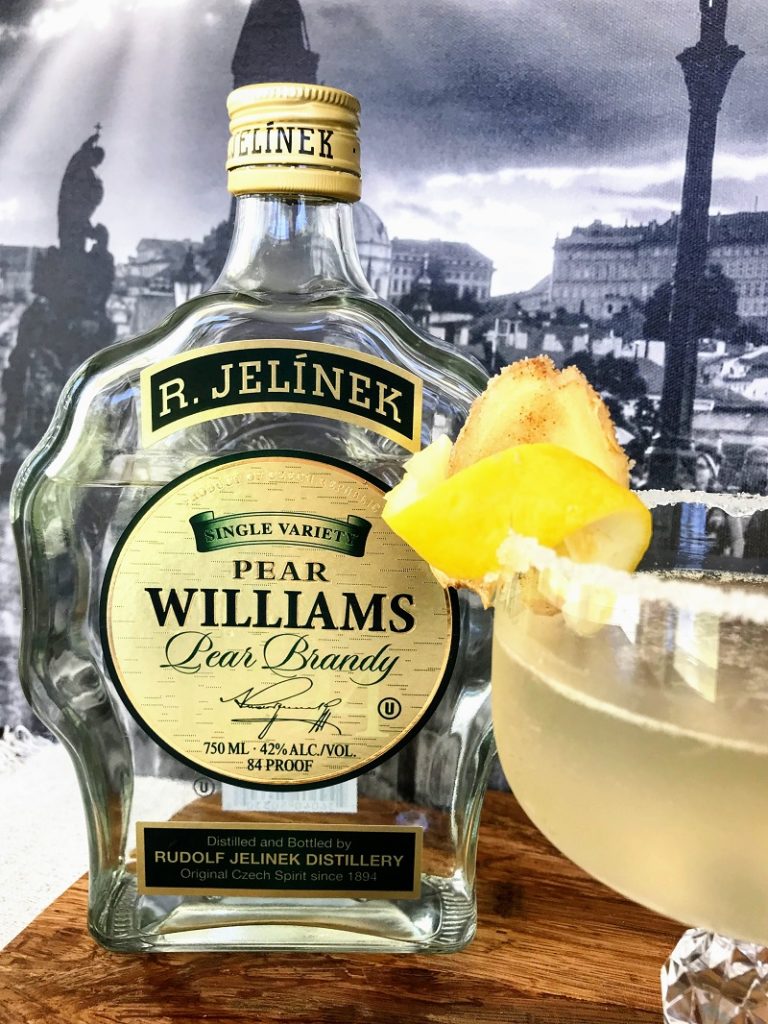
Pear Williams Pear Brandy truly tastes like they have packed an orchard into a bottle. I was so happy to learn that it’s in my local liquor store! When I spoke to the manager, he told me all about the ins and outs of getting your favorite Czech liquor into YOUR local store. And because I know how much you want to enjoy these new drink recipes as well as this delicious authentic Czech-made hruškovice (Pear Williams Pear Brandy), I dug even deeper and got you an actual contact!
Yes! You Can Get Some Here in the USA
You can email Robert Bokuvka, the Midwest Manager for R. Jelinek, directly at midwest@rjelinek.us and tell him the girls at TresBohemes.com sent you to order some for your local store!
You can thank me later, after enjoying your bottle while self-isolating. At least those of us who wanted to travel for spring and summer can still feel a sense of connection with all our Czech friends and neighbors across the sea! But even if that wasn’t the plan – you should pick up a bottle today!
I’m having a shot right now as my own personal COVID-19 preventative!*
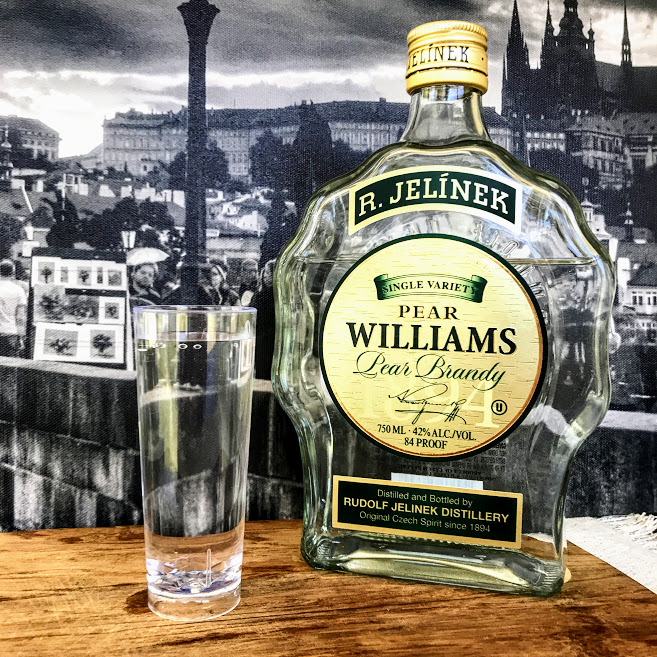
Na zdraví! (This means ‘cheers’ or, more literally, ‘to your health’ in Czech).
Notes:
After an afternoon of sampling Zachary’s five drinks, as well as drinking a shot of it plain, I must report I had no hangover and no headache the next day, which came as a complete surprise as I don’t usually drink so much, and if I do, I hate myself for the next few days. Surprisingly, this produced no such aftereffects.
Simple syrup is super easy to make. Just put two parts water and 1 part sugar in a pan. Keep stirring and heat until the sugar is completely dissolved. (Cover and let simmer for a few minutes for a thicker version.) This syrup is an essential sweetener for cocktails and many other drinks. You can also use it to sweeten your coffee, tea, lemonade, and mineral water. I always keep some on hand, at the bar, and in the fridge.
Orgeat syrup is a sweet syrup made from almonds, sugar, and rose water or orange flower water. It was originally made with a barley-almond blend. It has a pronounced almond taste and is used to flavor many cocktails. The kind you get in the local liquor store is just corn syrup and artificial flavoring. I recommend Small Hand Foods Orgeat Syrup which is made in the traditional French style, with the addition of apricot kernels which provides a distinct marzipan flavor without using extract.
DISCLAIMER: My personal writing is in no way a claim for a cure for any ailment, especially a virus. (1) According to the Surgeon General, women should not drink alcoholic beverages during pregnancy because of the risk of birth defects. (2) Consumption of alcoholic beverages impairs your ability to drive a car or operate machinery and may cause health problems. This website is designed for educational purposes only, and the information contained herein is not intended to be medical advice. The information provided on this website should not be used for diagnosing or treating any health condition. It is not a substitute for professional care. If you have or suspect you have a health problem, you should consult your healthcare provider. The authors, editors, producers, sponsors, and contributors of this website shall not be liable for any loss or damage alleged to have occurred as a result of the use of this website. If you believe you have a medical emergency, you should immediately call 911.
We tirelessly gather and curate valuable information that could take you hours, days, or even months to find elsewhere. Our mission is to simplify your access to the best of our heritage. If you appreciate our efforts, please consider donating to support this site’s operational costs.
See My Exclusive Content and Follow Me on Patreon
You can also send cash, checks, money orders, or support by buying Kytka’s books.
Your contribution sustains us and allows us to continue sharing our rich cultural heritage.
Remember, your donations are our lifeline.
If you haven’t already, subscribe to TresBohemes.com below to receive our newsletter directly in your inbox and never miss out.


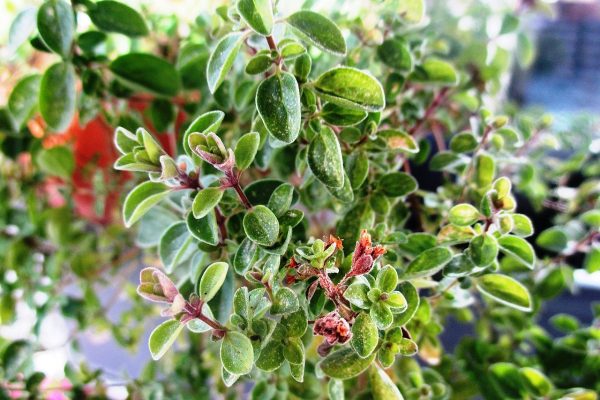
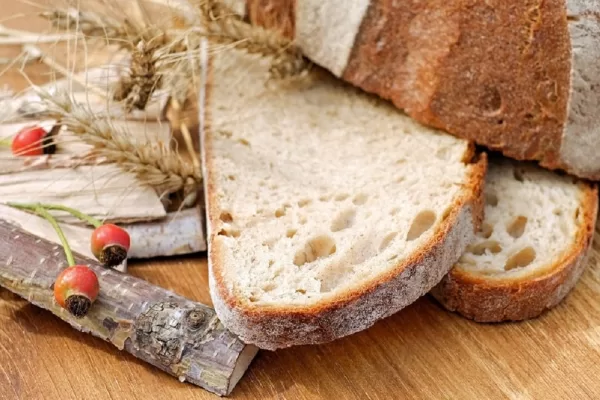
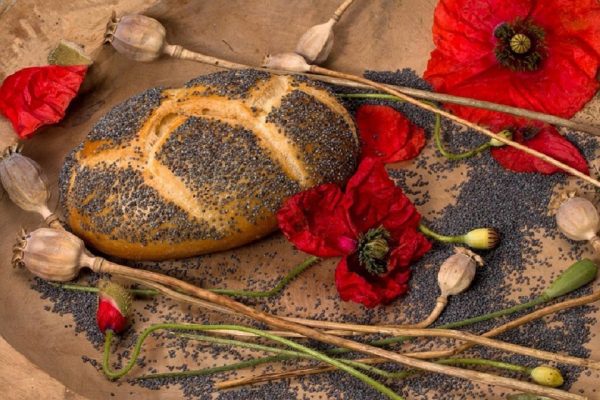















I purchased this on your recommendation and my wife and I enjoyed it very much. Thank you!